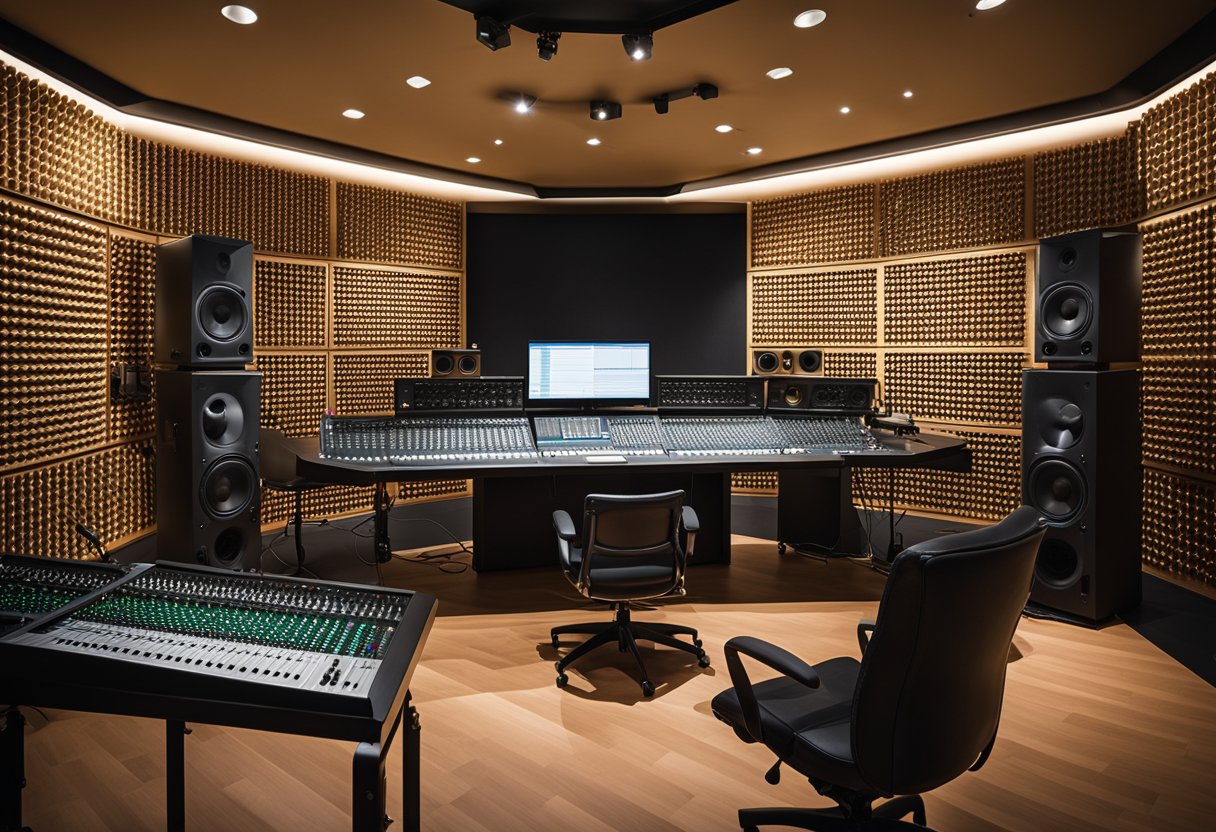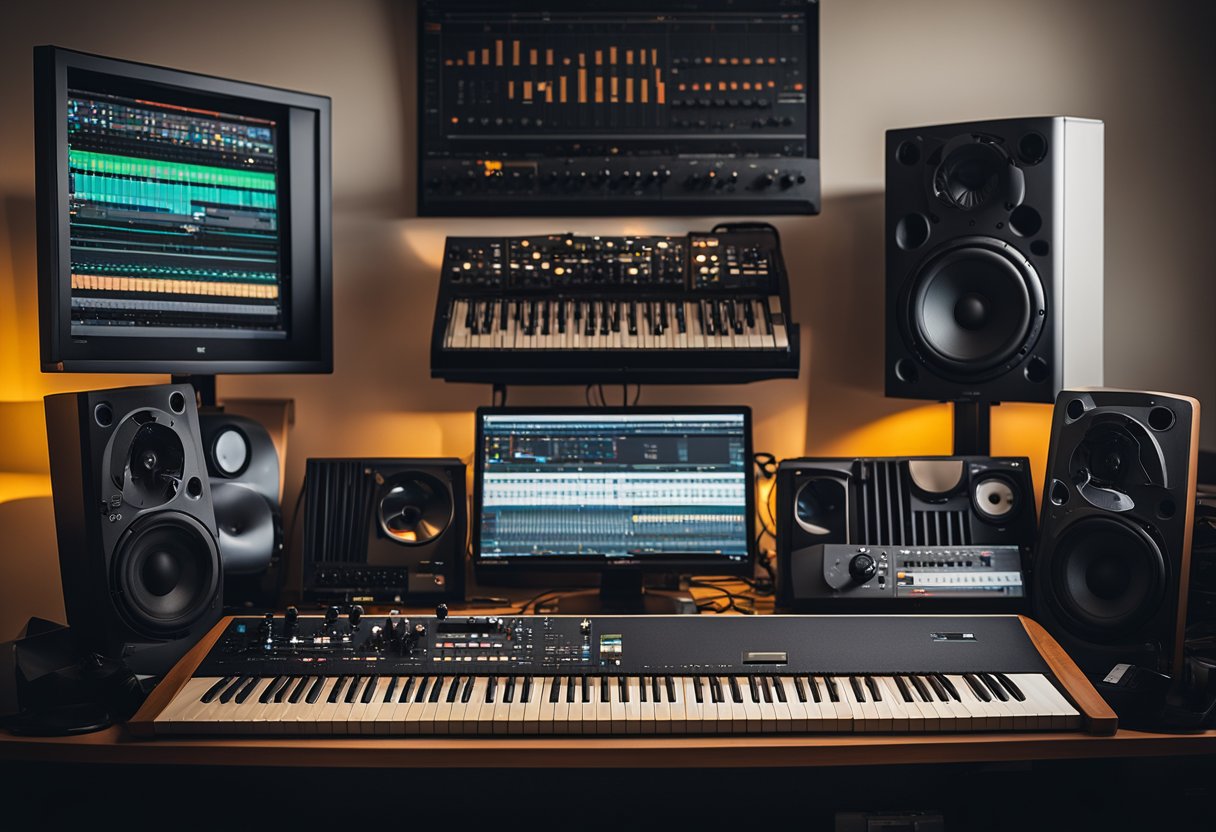Acoustics and room treatment are essential components of music production that can make or break the final product. Understanding the fundamentals of sound and room acoustics basics is crucial in creating an optimal environment for recording and mixing music. With the right acoustic treatment materials and strategies, producers can achieve a well-balanced and accurate sound that translates well across different playback systems.

One of the key considerations in music production is room measurement and analysis. By taking accurate measurements and analyzing the frequency response of the room, producers can identify problem areas and develop effective treatment strategies. It is important to note that acoustic treatment implementation is not a one-size-fits-all approach and requires careful consideration of the specific needs of the room and the desired sound.
Key Takeaways
- Understanding the fundamentals of sound and room acoustics basics is crucial in creating an optimal environment for recording and mixing music.
- Room measurement and analysis are essential in identifying problem areas and developing effective treatment strategies.
- Acoustic treatment implementation requires careful consideration of the specific needs of the room and the desired sound.
Fundamentals of Sound
Sound Wave Physics
Sound is a form of energy that travels through a medium, such as air or water, in the form of waves. These waves have two important characteristics: frequency and amplitude. Frequency refers to the number of cycles per second, measured in Hertz (Hz), while amplitude refers to the strength or intensity of the wave.
Frequency and Amplitude
Different sounds have different frequencies and amplitudes, which determine their pitch and volume, respectively. The human ear can detect frequencies ranging from 20 Hz to 20,000 Hz, although this range can vary depending on age and other factors. Amplitude is measured in decibels (dB) and ranges from 0 dB (the threshold of hearing) to 120 dB (the threshold of pain).
Human Hearing Range
Understanding the human hearing range is important in music production, as it helps producers and engineers to create balanced and pleasing mixes. For example, if a mix has too much energy in the low frequencies, it may sound boomy or muddy, while too much energy in the high frequencies can make it sound harsh or shrill.
In summary, sound is a form of energy that travels through a medium in the form of waves, with frequency and amplitude determining its pitch and volume. The human ear can detect frequencies ranging from 20 Hz to 20,000 Hz, and understanding the human hearing range is crucial in creating balanced and pleasing mixes.
Room Acoustics Basics

When it comes to music production, understanding the basics of room acoustics is essential. The way sound behaves in a room can greatly affect the quality of the final product. In this section, we will cover the three main aspects of room acoustics: sound reflection and absorption, room modes and standing waves, and diffusion and scattering.
Sound Reflection and Absorption
Sound waves bounce off surfaces in a room, creating reflections that can interfere with the direct sound from the source. This can cause problems with clarity and imaging. To mitigate this, it is important to use materials that absorb sound, such as acoustic panels, bass traps, and diffusers.
Acoustic panels are typically made of fiberglass or foam and are designed to absorb mid and high frequencies. Bass traps are designed to absorb low-frequency sound waves and are often placed in corners where bass tends to accumulate. Diffusers scatter sound waves in different directions, reducing the amount of direct reflections and creating a more natural sound.
Room Modes and Standing Waves
Room modes and standing waves are resonances that occur in a room due to the dimensions and shape of the space. These resonances can cause certain frequencies to be exaggerated or canceled out, resulting in an uneven frequency response.
To address this issue, it is important to understand the dimensions of the room and the frequencies that are affected by room modes. Bass traps can also help to reduce the impact of room modes by absorbing low-frequency sound waves.
Diffusion and Scattering
Diffusion and scattering are techniques used to create a more natural and spacious sound in a room. Diffusion scatters sound waves in different directions, reducing the amount of direct reflections and creating a more even sound. Scattering is similar to diffusion but is designed to scatter sound in a more random pattern.
Diffusers and scattering panels can be used to achieve these effects. It is important to place them strategically in the room to ensure that they are effective.
By understanding these basic principles of room acoustics, music producers can create a more accurate and immersive listening environment.
Acoustic Treatment Materials

Acoustic treatment materials are used to improve the sound quality of a room by controlling the way sound behaves within the space. There are three main types of acoustic treatment materials: absorbers, diffusers, and bass traps.
Absorbers
Absorbers are materials that absorb sound waves, reducing their intensity and preventing them from reflecting back into the room. Common absorbers include fiberglass, foam, and mineral wool. These materials are often used on walls, ceilings, and floors to reduce echo and improve clarity.
Diffusers
Diffusers are materials that scatter sound waves in different directions, creating a more even distribution of sound throughout the room. This can help to reduce standing waves and improve the overall quality of the sound. Common diffusers include wooden panels and specially designed diffuser panels.
Bass Traps
Bass traps are materials that absorb low-frequency sound waves, which can be particularly difficult to control in a room. They are often placed in corners or other areas where low-frequency sound tends to accumulate. Common bass trap materials include fiberglass, foam, and mineral wool.
When selecting acoustic treatment materials, it is important to consider the specific needs of the room and the type of music being produced. A professional acoustician can help to determine the best materials and placement for optimal sound quality.
Room Measurement and Analysis

Acoustic Measurement Tools
To properly treat a room for music production, it is essential to measure the acoustics of the space. There are several tools available for this purpose, including sound level meters, FFT analyzers, and impulse response measurement systems.
Sound level meters are used to measure the overall sound level in the room, while FFT analyzers can provide a detailed frequency analysis of the sound. Impulse response measurement systems can provide a complete analysis of the room’s acoustics by measuring the time it takes for a sound to decay after it is introduced into the space.
Room Analysis Software
Once the acoustic measurements have been taken, the data can be analyzed using specialized software. There are several software options available for this purpose, including Room EQ Wizard, REW, and FuzzMeasure.
These software programs can provide detailed visualizations of the frequency response of the room, as well as information about the room’s decay time and other important acoustic parameters. They can also be used to simulate the effects of different room treatments and help determine the best course of action for improving the room’s acoustics.
Interpreting Measurement Results
Interpreting the results of acoustic measurements can be a complex process, but it is essential for properly treating a room for music production. It is important to understand the different acoustic parameters being measured, such as frequency response, decay time, and reverberation time.
By analyzing these parameters, it is possible to identify problem areas in the room and determine the best course of action for improving the acoustics. This may involve adding absorption or diffusion treatments to specific areas of the room, or adjusting the placement of speakers and other equipment to optimize the sound.
Treatment Strategies

Listening Position Optimization
One of the most important aspects of room treatment is optimizing the listening position. This involves finding the best spot in the room for the listener to sit in order to achieve the most accurate sound reproduction. The ideal listening position is typically located at the center of the room, equidistant from the walls and speakers.
To optimize the listening position, it is important to consider the room’s dimensions and the placement of the speakers. It may be necessary to experiment with different positions and angles until the optimal location is found. Additionally, adding sound-absorbing materials to the walls and ceiling can help to reduce reflections and improve sound accuracy.
Speaker Placement
Proper speaker placement is also crucial to achieving accurate sound reproduction. The speakers should be positioned at an equal distance from the listener, forming an equilateral triangle. The speakers should also be angled towards the listener’s ears to ensure the best possible sound.
In addition, it is important to consider the placement of the speakers in relation to the walls. Speakers should be positioned away from walls to prevent reflections and standing waves. Placing the speakers on stands or isolating them from the floor can also help to reduce vibrations and improve sound quality.
First Reflection Points
Another important aspect of room treatment is identifying and treating the first reflection points. These are the points where sound waves first reflect off of the walls and reach the listener’s ears. Treating these points can help to reduce reflections and improve sound accuracy.
To identify the first reflection points, a mirror can be used to reflect a light source off of the walls. The points where the light reflects back to the listener’s ears are the first reflection points. Treating these points can be done by adding sound-absorbing materials such as acoustic panels or diffusers to the walls.
Overall, optimizing the listening position, speaker placement, and treating first reflection points are key strategies for achieving accurate sound reproduction in a music production room.
Acoustic Treatment Implementation

DIY Acoustic Panels
One of the most popular and cost-effective ways to implement acoustic treatment is by building DIY acoustic panels. These panels can be made using materials such as fiberglass insulation, wooden frames, and acoustic fabric. They can be easily customized to fit the specific needs of the room and can be designed to absorb or diffuse sound.
When building DIY acoustic panels, it is important to ensure that the materials used are safe and effective for sound absorption. Fiberglass insulation, for example, can be hazardous if not handled properly. It is also important to consider the thickness and density of the panels, as well as their placement in the room.
Commercial Acoustic Solutions
For those who prefer a more professional approach, there are many commercial acoustic solutions available on the market. These can range from simple foam panels to more advanced diffusers and bass traps. Commercial solutions can be more expensive than DIY options, but they often come with more advanced features and are designed to be more effective.
When considering commercial acoustic solutions, it is important to research the different options available and choose a product that is appropriate for the specific needs of the room. It is also important to consider the cost and installation requirements of each product.
Aesthetic Considerations
While the primary goal of acoustic treatment is to improve the sound quality of a room, it is also important to consider the aesthetic impact of the treatment. Acoustic panels and diffusers can be designed to blend in with the existing décor of the room, or they can be used as a statement piece to add visual interest.
When choosing acoustic treatment options, it is important to consider the overall design aesthetic of the room and choose products that complement the existing décor. This can help to create a cohesive and visually appealing space that also provides optimal sound quality.
Monitoring and Mixing in Treated Rooms

A well-treated room can significantly improve the accuracy of monitoring and mixing in music production. A treated room minimizes the effects of reflections, standing waves, and other acoustic distortions that can interfere with the sound quality.
One of the most important considerations when monitoring in a treated room is the positioning of the speakers. The speakers should be positioned so that they form an equilateral triangle with the listener’s head. This ensures that the sound is directed towards the listener’s ears without any obstructions or reflections.
Another important factor is the choice of monitors. Monitors with a flat frequency response are ideal for accurate monitoring. It is also important to ensure that the monitors are placed on stable stands or mounts that do not vibrate or resonate.
In addition to monitoring, mixing in a treated room can also be improved. A well-treated room provides a more accurate representation of the sound, allowing the producer to make more informed decisions during the mixing process.
Overall, monitoring and mixing in a treated room can greatly enhance the quality of music production. By reducing the effects of acoustic distortions, producers can achieve a more accurate and consistent sound.
Advanced Acoustic Concepts

Psychoacoustics
Psychoacoustics is the study of how people perceive sound. It is a crucial aspect of room treatment because the way a room sounds can affect how a person hears and interprets sound. For example, if a room has too much reverb, it can make it difficult to distinguish between different sounds. Understanding psychoacoustics can help in designing a room that provides an accurate representation of sound.
Soundproofing vs. Acoustic Treatment
Soundproofing and acoustic treatment are often confused, but they are two different things. Soundproofing is the process of preventing sound from entering or leaving a room. Acoustic treatment, on the other hand, is the process of controlling the sound within a room. While soundproofing is important, it does not necessarily improve the quality of sound within a room. Acoustic treatment, on the other hand, can greatly enhance the sound quality in a room.
Hybrid Absorptive/Diffusive Designs
Hybrid absorptive/diffusive designs are becoming increasingly popular in room treatment. These designs use a combination of absorptive and diffusive materials to create a balanced sound within a room. Absorptive materials, such as foam or fiberglass, absorb sound waves, while diffusive materials, such as diffuser panels, scatter sound waves. A room with only absorptive materials can sound dead, while a room with only diffusive materials can sound too reflective. A hybrid approach can create a more natural and balanced sound.
In summary, understanding psychoacoustics can help in designing a room that provides an accurate representation of sound. Soundproofing and acoustic treatment are two different things, and while soundproofing is important, it does not necessarily improve the quality of sound within a room. Hybrid absorptive/diffusive designs can create a more natural and balanced sound within a room.
Frequently Asked Questions

What materials are effective for acoustic treatment in a home studio?
Acoustic foam panels, fiberglass panels, and diffusers are all effective materials for acoustic treatment in a home studio. Foam panels are the most common and affordable option, but they may not be as effective as fiberglass panels or diffusers in treating low-frequency sounds. Fiberglass panels are more effective at treating low-frequency sounds, but they can be more expensive and difficult to install. Diffusers are designed to scatter sound waves, making them ideal for treating reflections and echoes in a room.
How can I improve the acoustics of a room for better music production?
Improving the acoustics of a room for better music production involves reducing reflections and echoes in the room. This can be achieved through the use of acoustic treatment materials such as foam panels, fiberglass panels, and diffusers. Additionally, placing furniture and other objects in the room can help to absorb sound waves and reduce reflections. It is also important to ensure that the room is properly ventilated and has good air circulation, as this can affect the acoustics of the room.
What are the essential elements of room treatment for home audio setups?
The essential elements of room treatment for home audio setups include treating early reflections, reducing standing waves, and controlling bass frequencies. This can be achieved through the use of acoustic treatment materials such as foam panels, fiberglass panels, and diffusers. Additionally, using bass traps in the corners of the room can help to control low-frequency sounds and reduce standing waves.
How do you properly implement sound treatment panels for optimal audio quality?
To properly implement sound treatment panels for optimal audio quality, it is important to consider the placement and orientation of the panels. Panels should be placed at the first reflection points in the room, which are typically the walls directly opposite the speakers. The orientation of the panels should be perpendicular to the direction of the sound waves. It is also important to use the right type of panel for the specific frequency range you are trying to treat.
What budget-friendly methods exist for acoustically treating a room?
Budget-friendly methods for acoustically treating a room include using DIY acoustic panels made from materials such as rigid fiberglass insulation or rockwool. These materials can be purchased in bulk and cut to size to create custom panels. Additionally, using thick curtains or blankets can help to absorb sound waves and reduce reflections.
How can I use an acoustic treatment calculator to enhance my studio’s sound?
An acoustic treatment calculator can help you to determine the optimal placement and number of acoustic treatment panels for your specific room and setup. By inputting the dimensions and other information about your room, the calculator can provide recommendations for the placement and number of panels needed to achieve optimal sound quality. This can help to ensure that you are using the right type and number of panels for your specific needs.



